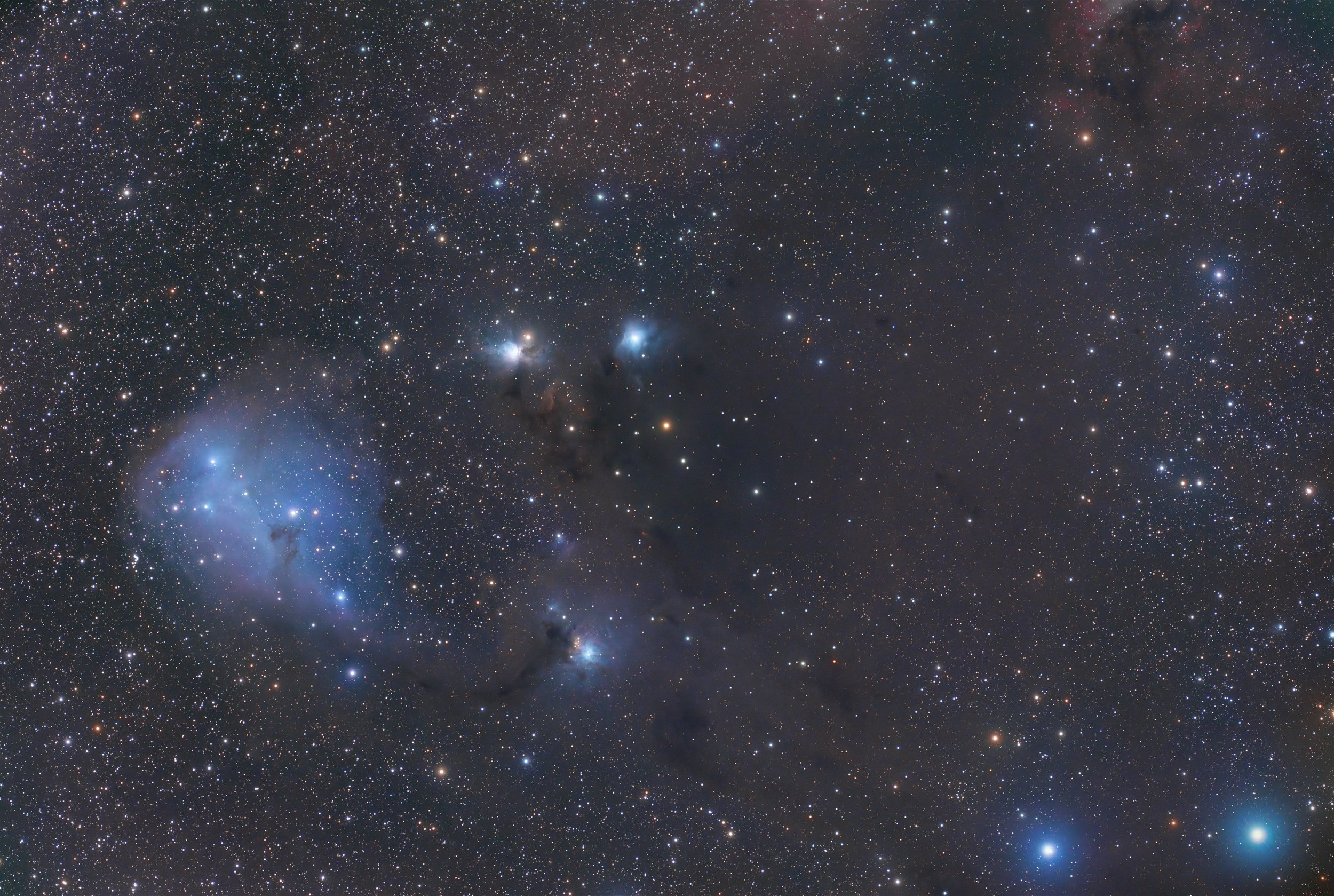
AAPOD2 Image Archives
IC1848 - The soul Nebula in HOO
IC 1848, commonly known as the Soul Nebula, is a vast emission nebula in the constellation Cassiopeia, approximately 7,500 light-years away. This region is a rich tapestry of star formation, with intricate filaments of ionized hydrogen and oxygen creating a breathtaking visual display. Captured using a cooled color camera and the L-Ultimate narrowband filter, this image combines H-alpha (H) and Oxygen III (O) data in the HOO palette, producing a vivid blend of red and blue hues that highlight the nebula’s complex structure.
The Soul Nebula harbors several embedded open star clusters, including IC 1848, whose stellar winds and radiation sculpt the surrounding gas and dust. Within the nebula, ongoing star formation illuminates bright rims and dark Bok globules, where future stars may still be forming. This narrowband capture accentuates the fine structures of ionized gas and faint details that would be lost in broadband imaging, offering a glimpse into the dynamic processes that shape this stellar nursery.
IC 1848 (AKA Soul Nebula, Embryo Nebula or W5)
The Soul Nebula, also known as IC 1848, shines with captivating brilliance when viewed through narrowband filters that isolate specific wavelengths of light. This celestial masterpiece, located in the constellation Cassiopeia and approximately 6,500 light-years away from Earth, unveils its ethereal beauty in this narrowband image. The specialized filters emphasize the emissions from ionized hydrogen and oxygen, highlighting the intricate tendrils and glowing clouds of the nebula in stunning detail. In this cosmic portrait, the Soul Nebula's radiant pinks and deep reds come to life, revealing a celestial dreamscape where new stars are born amidst the interstellar clouds. This narrowband view of the Soul Nebula offers a mesmerizing glimpse into the hidden wonders of the universe, where the dance of light and gas paints a masterpiece that transcends both time and space.
IC1848 Soul Nebula
Image Description and Details : IC1848 Soul Nebula.
Soul nebula IC1848, narrowband processed. The stars are forming in the soul of the Queen of Ethiopia. More specifically, in a star-forming region called Soul Nebula can be found in the constellation Cassiopeia, a constellation Greek mythology identified as the arrogant wife of a king who has long ruled the lands around the top river Nile. the Soul nebula contains several open clusters of stars, an intense radio source known as W5 and huge bubbles formed by winds from massive young stars. Located about 6,500 light-years away, the Soul Nebula spans about 100 light years.
Technical data:
Remote Observatory "FarLightTeam"
Team: Jesús M. Vargas, Bittor Zabalegui,José Esteban, Marc Valero.
Telescope: Takahashi FSQ106 ED 530mm f/5
CCDs: QSI683 wsg8
Filters: Baader Planetarium - Halpha-SII-OIII
Mount: 10Micron GM1000 HPS
Imaging Software: Voyager
Processing Software: PixInsight-AstroPixelProcessor
Imaging Data:
Captured through 12 December 2021 to 21 February 2022, ( Fregenal de la Sierra ) Badajoz, Spain.
Image composed of a Mosaic of 2 tiles:
Ha: 94x1200"
SII-OIII: 147x1200"
Darks, flats, bias
Copyright: Remote Observatory "FarLightTeam"
Team: Jesús M. Vargas, Bittor Zabalegui,José Esteban, Marc Valero
A whole lotta soul ic1848
Image Description and Details : Ic 1848. The soul nebula
I am completely IN LOVE with this area of the sky. The nebulosity is so incredible. wide field or close. It's so wonderful
I was able to capture this over 5 nights.
I went to a high gain for a while but ti is challenging to calibrate out so I returned to 200_50 after this image
~~~~Tekkie stuffs:
Telescope: Explorer scientific Ed 80 FCD-100
Camera: ASI1600pro
Filters: Astrodon E series
Mount: Atlas EQ-G
Guiding camera: 290 mini with OAG
SHO~. 84:86:85 300 sec images
Total integration time: 21.25 hours
Seeing/ environment: 2-3
Bortle Class: Class 5/6 Backyard~ Central Indiana
Dates of acquisition: 10/4-5 11/5-8, 2020
processing Pixinsight:
processing: considerations. MULTIPLE nights with good alignment (2 degree error allowed in SGP)
synth lum created for Decon
Aligned all to each other.
Crop
DBE individually
SHO combine with 15% of Ha added to R and 10% to Blue
SHO workflow~BGN; MLT for Noise reduction
Lum workflow~decon with autopsf 40 iterations 5 layers;
MLT for noise reduction
Arc sin for SHO and chose HT for Lum with Bg at 10% for both
TGVDN
LHE after for small and larger kernels masked for the nebula
Curves with range and color and Lum masking for lightness and sat boost
LOADS of masking to bring colors.
XPTR with Lum mask for lum boost;
MLT for sharpening.
Morph to reduce the stars just a bit and ICC to end
Copyright Information: Dawn Lowryl





